[NB: read a later post, “Marcelli’s Annervated Lunge, Revisited” for more recent thoughts on this: https://saladellatrespade.com/2023/02/27/marcellis-annervated-lunge-revisited/]
One of the hallmarks of the Roman-Neapolitan school of fencing is the stoccata annervata or annervated thrust. A fencer today examining the illustrations in Marcelli or Pallavicini’s works may find this particular action odd as it looks so stiff and awkward in comparison to the bent-leg lunge of today (a.k.a. a stoccata if to the inside line, imbroccata if to the outside line/outside the arm). Wiser and more-knowledgeable heads than mine have explored this variety of the lungish attack far better than I can. [1] Thus, while I cannot add much to their conclusions I must, like anyone else wrestling with a source, figure out how to perform this maneuver and teach it. What follows is my working interpretation at present, and I share it less because I’m convinced I’m correct than because it illustrates another example of a fencer working closely from a source.
The translation I rely on is Christopher A. Holzman’s–his is the first translation into English and perhaps one of his greatest contributions to the historical fencing community. This is not to denigrate in any way his Del Frate or other offerings, but to say that Marcelli’s Rules of Fencing (1686) is easily one of the finest works on fencing ever written. It’s value extends beyond the weapons he covers (chiefly rapier and associated side-arms)–for his coverage and explanation of universal principles alone Marcelli is a must-have source. Much as I hate the parlor-game question–“if you were on a desert island and had only one X, what would it be?”–I can answer it for works on fencing: it would be Rules of Fencing. [2]
My academic training urges me to find the best translations I can, but never to forget the original source. Thus, while I rely on Chris’s excellent Marcelli, when it comes down to anything I must investigate closely I make sure to read the Italian next to it. I provide the original Italian after quotations in English below. Note: I am not fluent in Italian. I have only a functional get-the-gist-of-it ability and only for things like fencing or ancient and medieval history. Wine-lists, menus, Dante, yeah, can’t read those (yet). Like many historians working in early European topics I must have a working command of some languages in order to identify if not read key secondary works in languages other than my own. [3]
Here, I will share some key passages for the annervated thrust, then share how I’m reading them and why.
Pallavicini (1670/1673):
Giuseppe Moriscato Pallavicini, in his Fencing Illustrated (2 vols., 1670 and 1673), provides useful depictions of this annervated attack:
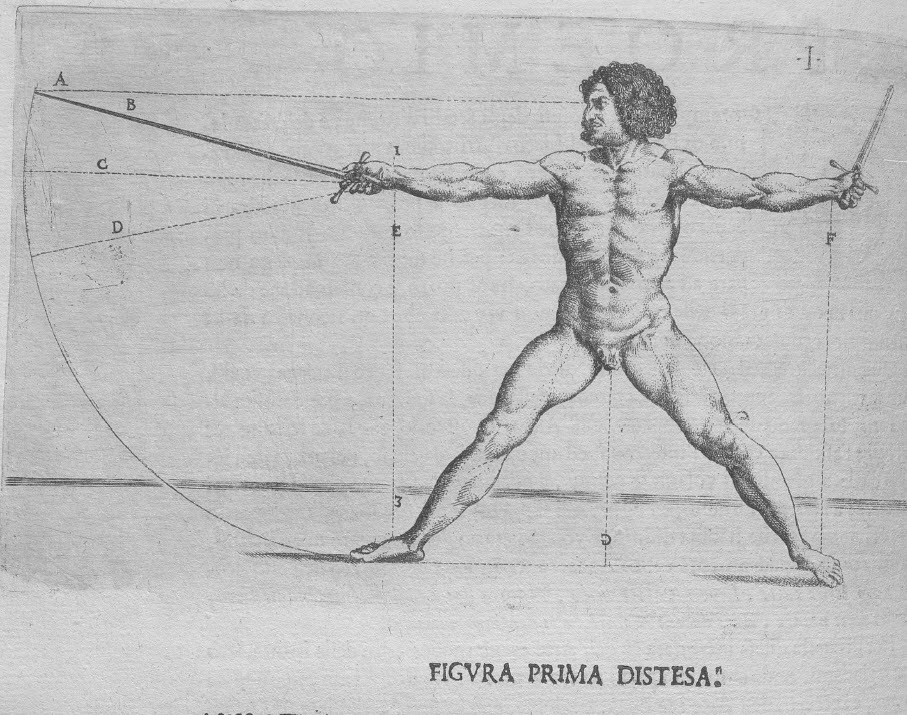
The explanation Pallavicini offers for the first illustration (p. 2) explains how one launches the attack:
The present figure shows the visual line with the assigned letter A, so, at the point of standing in stance, the the first thing is of the right arm going out, then tensing the left knee (which is bent) and in tensing it, extending it, the right foot is made to advance on the ground performing the thrust in 3rd.
[Figura mostra la linea visuale per la lettera assegnata, A, al punto cosí standon in piāta, la prima cosa e d’uscire primo il braccio destro, è doppo annervare il ginoccho sinistro, in cui stando curvo, & in annervandolo disteso, fà avanzare il piede destro in terra, e tirando la stoccata di terza…] [4]
We see a similar completed attack on page 7 where the author describes the drill of thrusting against a hanging ball:
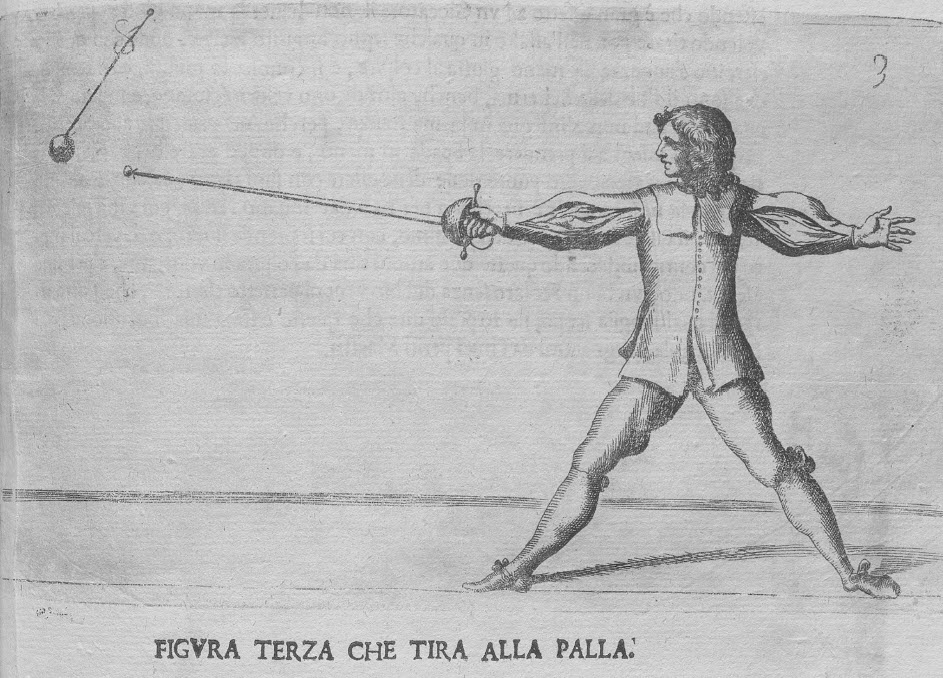
For the sake of comparison, here is the same maneuver from another contemporary master, Giuseppe Villardita, author of A Compendium of Sicilian Fencing/La Scherma Siciliana ridotta in Compendio (1670):
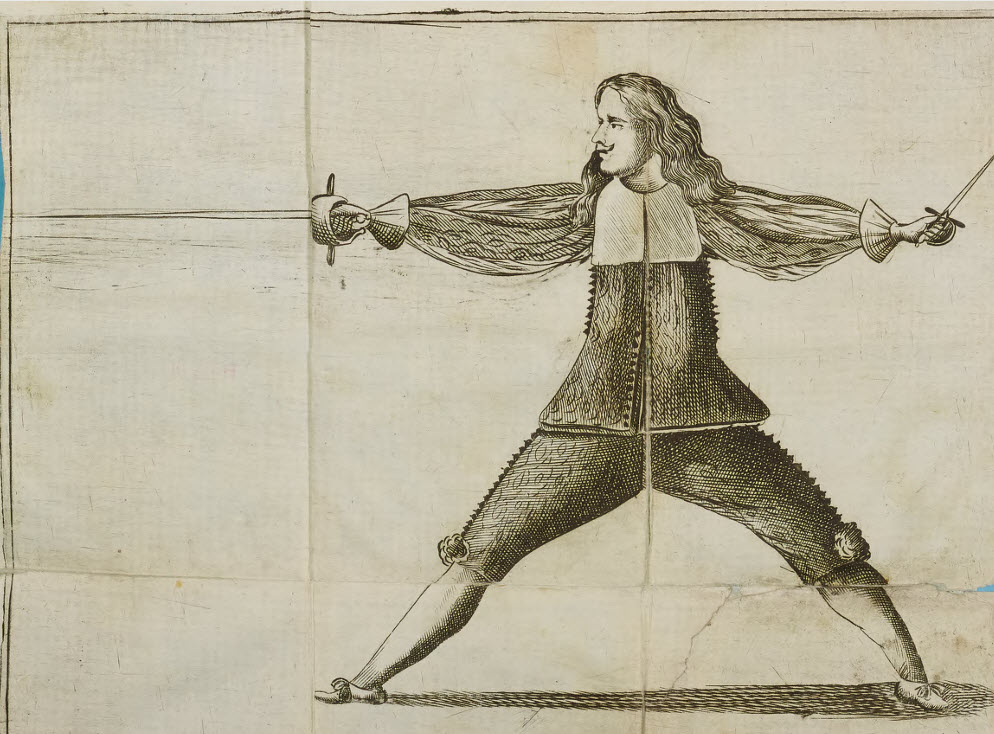
Franceso Marcelli (1686):
While other works within the Roman-Neapolitan orbit I find useful for context I focus mostly on Rules of Fencing/Regole della Scherma (1686). Like others within this tradition Marcelli employs an annverated attack, but importantly spends as much time or more on a version of the lunge ancestral to the modern iteration.
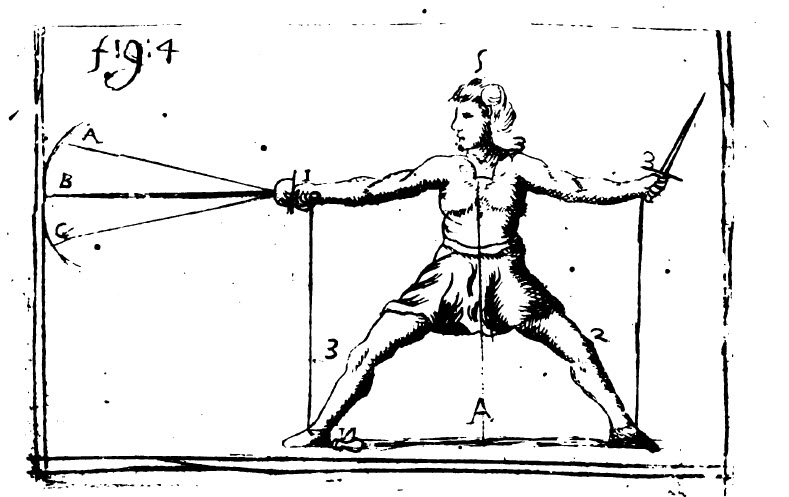
Accompanying this image Marcelli writes:
All the movements that I have proposed to be made in performing the thrust are seen marked with the numbers in the present illustration. The number 1 signifies that the aforesaid Cavaliere has started the sword hand first. The number 2, marked near the left knee, denotes that after having brought the hand forward he has violently extended that knee, which was bent. The number 3 that stands at the right foot indicates that it was the third movement of the body, and that after having advanced the hand and extended the knee he has advanced the foot, which is the last movement, because it has to do the least travel of all.
[Tutti i moti, che hò proposto da farsi nel tirar la Stoccata, si veggono segnati co’i numeri nella presente figura; dove il nu. 1 significa, che il sopradetto Caval. hà partito prima la mano della spada. Il num. 2., segnato vicino il ginocchio sinistro, dinota, che doppo haver anticipate la mano, hà disteso con violenza quel ginocchio, che stave piegato. Il num. 3., che stà nel pie destro, signitica, che quello e stato il terzo moto del corpo; e doppo haver caminato la mano, & annervato il ginocchio, ha caminato il piede, il quale e l’ultimo moto, perche hà da far camino meno di tutti.] [5]
Interpretation:
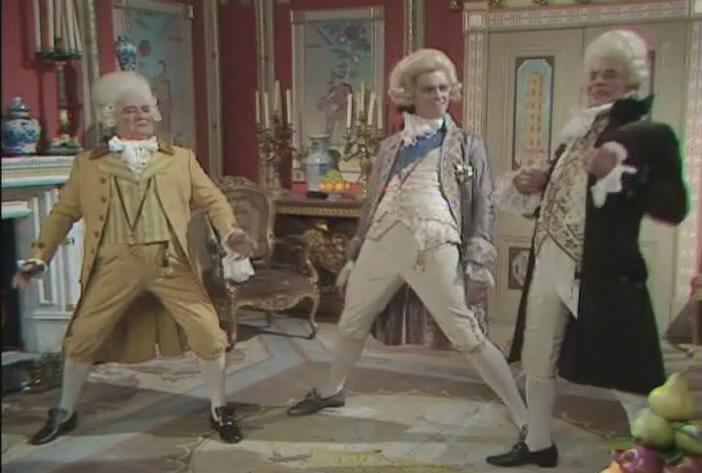
Looked at alone these images, as useful as they are, can be misleading. Taken literally one is likely to jam the knee, slip, or split one’s pants. No matter how well rendered we must be cautious with images. We must read them with any accompanying text, and, consider how the fencer gets to this position. Put another way, what does the guard position one is in prior to launching the attack look like? Placed side by side what can we deduce about moving from guard to annervated thrust?
Here is one example from Pallavicini, Vol. 1, for the guard position:
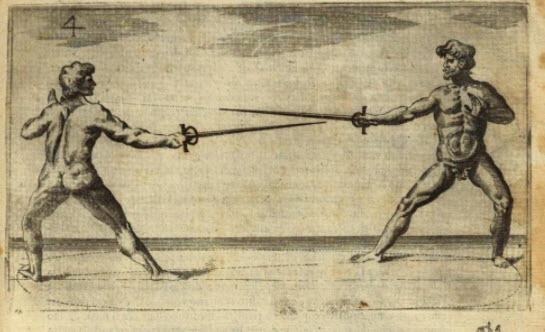
And here is an example from Marcelli:
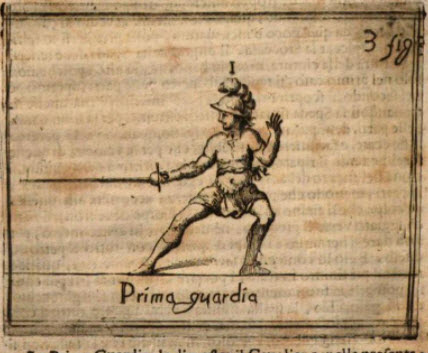
The guard position is back-weighted, body upright, rear arm up and out of the way (if unarmed), front foot toward the opponent, and weapon directed to target. The rear shoulder, so Marcelli remarks, should be over the bent rear knee. The weapon hand should be about belt high (cf. Marcelli, CH, 83ff).
Critical to understanding this style of attack is how one most easily shifts from this rear-weighted guard position to the annervated thrust. As Marcelli states the right or lead foot doesn’t move very far, and both Pallavicini and Marcelli are explicit about the speed and force used in snapping the left or rear leg into an extended position forcing the right foot forward.
This is less a lunge per se than a quick step made by shifting weight from the rear leg to the front. It is shorter than than lunge as we know it, and must be because landing straight-legged on the front foot is not something comfortable or safe to do if the step is too long. The Roman-Neapolitan masters took time to explain just how far one should stand in guard.
Pallavicini, for example, explains
In order to know how large the man’s stance must be, the proper distance is a third part of the man’s height, counting from the left heel to the narrowest part of the right foot, as my Figure shows, marked with a straight line from the point of the left heel where the right foot is placed over the same line, since it shows a distance of three and a half palmi [approx./ 8.5-10 inches/20-25cm], in which the man comes to stand more comfortably in the proper proportion of the stance. Since this Figure stands with the point of the sword in the ground, I have made it easier for the student to know how to find the proper length of the stance, which is made by bending the left knee, and advancing the right foot on the straight line. In order to know how much the right foot must be advanced, the sword point is placed on the ground, and keeping the left knee bent, and the right knee extended, the body stays in the center, as my Figure shows, and the right foot must advance as much as needed to touch the sword point.
[e così per sapere la quantità quanto l’huomo deve star largo di passo, la guista distanza è la terza parte dell’altezza dell’huomo, numerando dalla punta del Tallone sinistro per insino alla legatura del piede destro, come mostra la mia Figura segnata con la linea retta, della punta del tallone sinistro dove posa il piede destro sopra la medesima linea retta benche mostra la distanza delli tre palmi e mezzo, nella quale l’huomo viene à stare più commodamente nella giusta proportione della pianta, e benche stia questa Figura con la punta della Spade in terra, l’hò satta per più faciltà dello Scolaro, per sapere trovare la giusta distanza della pianta, la quale si fà curvando il ginocchio sinistro, e doppo avanzare il piede deitro per la linea retta, e per sapere quanto deve avanzare il piede destro s’abassa la punta della Spada in terra, e tenēdo il ginocchio sinistro piegato, & il ginocchio destro difesto, & il corpo che stia in cētro, come mostra la mia Figura, & il piede destro deve avázare táto quanto hà di toccare la punta della Spada.] [6]
Pallavicini illuminates this notion thus:
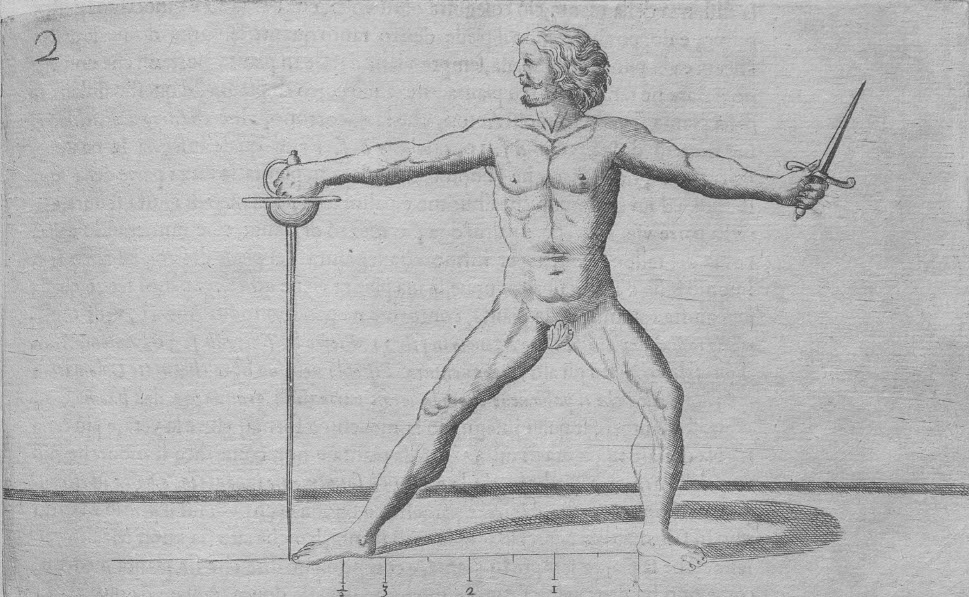
Marcelli’s treatment of the type of steps and guard position are separate, but the latter assumes the former. For example, in explaining how ones comes into guard he writes
having first planted the left foot on the ground, he should bring the right foot forward as much as is necessary to form a correct and proportionate stance, in relation to the distance of the step with which the blow must be extended, in order to be able afterward to easily recover with it (a thing so necessary, and of such consequence, that upon this depends the good or bad outcome of the operation).
[Impugnata in tal maniera la Spada, e piantato prima in terra il pie sinistro, porri avanti il pie destro, tanto, quanto basta a formare un passo giusto, e proporionato, respetto all distanza del passo, co’l quale si deve distendere il colpo, per potersi doppo con esso rihavere con facilita (cosa tanto necessaria, e di tanta conseguenza, che da questa dipende il buono, o cattivo successo dell’operatione).] [7]
This makes far more sense when one recalls the earlier passage on the types of steps. For brevity these are:
- the straight step: made when one moves along the line of direction
- the traversal or oblique step: made when we leave the line of direction and go left or right
- the mixed step: a good example is the inquartata
- the curved step: made when gaining, passing, or seizing the opponent’s weapon vs. returning to guard
[Quattro forti de’Passi si possono formare nel caminare à fronte del suo
nemico. Il primo è’l Passo Retto. Il secondo, è’l Passo Trasversale, or vero
obliquo. Il terzo, è’l Passo Misto. È’l quarto e’l Passo Curvo.
Il passo si fà, quando si camina per linea retta incontro del suo nemico, e
si move à dirittura per quella medesima linea nella quale stà situaro il suo
contrario. Questo si dice, caminar retto.
Il Passo Trasversale, ò vero Obliquo, è quel passo, il quale si forma,
quando uscendo dalla linea retta si camina a man destra, ò à man sinistra del
suo contrario…
Il Passo Misto, è quel passo, che si fà con l’Inquartata, quando che si
hanno da sfuggire le stoccate che son tirate di dentro…
Il Pass Curvo si fà solamente, ò nel guadagno, ò nelle passate; benche in queste non si finischi di terminarlo, con tutto ciò da questo passo si guidano… [8]
This is, as Marcelli himself remarks, a “natural and composed posture of the body” and easily adjusted to navigate measure and set the stage for one’s choice of footwork. We unconsciously manage this all the time whenever we’re on guard; we adjust measure, we shift our feet, we shorten or lengthen steps based on what it is we need or wish to do.
Conclusion
The necessity for (relatively) easy movement, combined with a guard position designed to keep the weapon out and oneself as far back as possible, makes little sense if one of the primary methods to deliver a thrust is awkward. Just as one doesn’t serve up popsicles on fine china, so too does one avoid a stilted, jarring attack from an efficient, sophisticated guard. It needs to work.
These masters, Marcelli especially, were not simple-minded. Their students might be wounded or die if their teaching included some walk-like-an-Egyptian-lunge. It doesn’t follow. If in our interpretations we find ourselves landing with pain on the front leg, if we are off balance, then likely we are missing something.
So, what is this annverated attack then? It’s a from of half-lunge. Like the bent front-leg lunge this version uses the rear leg to propel the body forward. Nothing, however, happens until that weapon moves first. The lead foot is lifted a short way and set down with a straight leg. It’s this last portion that is different and a little tricky at first.
A natural question is why use such an attack? Part of the answer is about the context in which the Roman-Neapolitan school developed, one in which Spanish destreza played a significant role. Many of these masters quote from Carranza, Narváez, and Pacheco just as they do the luminaries of the Dardi School and others (see for example Pallavicini, Vol. 1, p. 78, in Holzman’s translation). [9] Another reason is the reality of a sharp point. In an age when most people learned to fence to protect themselves defense was foremost. Our study, however dedicated, is removed in time and purpose from the very real danger of being spiked, and so we are accustomed to taking chances we likely wouldn’t were our weapons sharp. This is a point I make a lot and I won’t belabor it here, but in sum the annervated attack is less extended, easier to recover from, and a compromise between reach to target and the dangers of over-extension.
I’m still working on this attack, but as I read and reread the sources, as I try out this annervated thrust with students, the one thing that comes to mind each time we work on it is that this had to work at least somewhat well to have appeared in works from at least 1670 to 1725 (give or take some years). Chris Holzman suggests in his translation of Nicola Terracusa e Ventura’s True Neapolitan Fencing (1725) that this interesting form of attack seems to have gone out of fashion by the time Rosaroll & Grisetti penned their magnificent The Science of Fencing (1803). The bent front-leg lunge we see in Marcelli, and which we see little of in Terracusa e Ventura, is the precursor of the lunge that most of us have learned since. [10]
Why did the annervated attack disappear? One reason may be that by 1800 fencing, while still important–especially in Italy and France where the duel survived longest–had also long been transforming into a past-time and sporting pursuit. The conservatism of the annervated thrust is less well-suited to the speed necessary in agonistic fencing, ditto the less aggressive reach to target. So much of rapier has analogues in modern epee and foil, but this attack, this odd somewhat stilted looking thrust, is an exception that allows us a unique look into the Art’s more serious past.
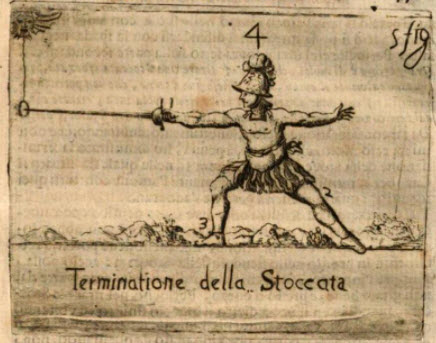
NOTES:
[1] See especially Francesco Marcelli, Rules of Fencing, Trans. by Christopher A. Holzman (Wichita, KS: Lulu Press, 2019), and Francesco Loda, Historical Fencing Manual: Rapier-Fencing in the 17th and 18th Centuries (Wheaton, IL: Freelance Academy Press, 2019).
[2] Feel free to disagree. The two works that I have found comprehensive, not only for technique but theory, are Marcelli and the later Science of Fencing by Rosaroll & Grisetti.
[3] European colleagues are often at an advantage in language acquisition. Living so close to other language populations and a longer tradition of language study make a difference. Outside of Latin, Middle Welsh, and Classical Irish, the three languages I spent the most time on, as a late Romanist/early medievalist I needed to be able to read some Greek, German, French, and Italian. With the exception of Latin and perhaps Middle Welsh, where I’m arguably semi-literate, I consider myself functionally illiterate in the other languages outside the extremely restricted works on history and fencing that have been my focus.
It should be obvious, but for any long passage and certainly anything I publish I always have someone expert in the language check my translation and/or interpretation of what I read. I do this even with the Latin translation work I do because it’s due diligence; it’s equally important to mention this expert help as well.
[4] Pallavicini, Fencing Illustrated, Vol. 2, p. 2; Holzman, The Second Part of Fencing Illustrated by Giuseppe Moriscato Pallavicini (Witchita, KS: LuLu Press, 2020), 1. The image of the fencer thrusting at the ball is on page 7 in Pallavicini, and page 11 in Holzman’s edition of Vol. 2. See also Giuseppe Villardita, A Compendium of Sicilian Fencing/La Scherma Siciliana ridotta in Compendio (Palermo: Imp. Cuzol. G.V.G. Imp. de la Torre R.P., 1670), image between pages 28 and 29 in Google Books.
[5] Marcelli, Rules of Fencing, Bk I, Part II, Ch. V, p. 15, fig. 4; Holzman, 288.
[6] Pallavicini, Fencing Illustrated, Vol. 2, 5; Holzman, 7.
[7] Marcelli, Rules of Fencing, 62-63; Holzman, 84.
[8] Marcelli, Rules of Fencing, 31-32; Holzman, 37.
[9] See for example Pallavicini, Fencing Illustrated, Vol. 1, Trans. Holzman, xi-xiv; Loda, Historical Fencing Manual: Rapier-Fencing in the 17th and 18th Centuries, 1-12; 38, n. 49. Dr. Loda notes that the upright stance of the annervated thrust recalls the upright stances common to much of destreza.
[10] See Nicola Terracusa e Ventura, True Neapolitan Fencing, Trans. by Christopher A. Holzman (Wichita, KS: Lulu Press, 2017); Rosaroll & Grisetti, The Science of Fencing, Translated by Christopher A. Holzman (Witchita, KS: Lulu Press, 2018).
POST SCRIPT: I need to get better photos with the measuring tape, but I did an experiment this morning [9 Nov. 2021] to test out the proportions of the guard and annervated thrust. Using the method mentioned above where one uses the sword to step toward when I’m in the Neapolitan guard there is approximately 18″/45.72cm distance between my left/rear foot and the heel of my lead/right foot. Depending on the degree of bend in the rear leg this can extend to 2’/61cm distance between my feet. This accords pretty well with the proportions Pallavicini lists, that is, that the space between my feet is about a third of my height when on guard. An annervated thrust from this stance is super short in terms of how far forward the front foot extends.

I had a chance to speak with my good friend Patrick Bratton, Sala della Spada, in Carlisle, PA, and he shared the following:
“One thing I’ll add that helps with this I’ve found in practice is that this was typically done with both sword and dagger, and Marcelli’s sword and dagger guards have the sword low and retracted like in his 1st guard. That essentially works as an absence of blade guard and it can really play with your opponent’s sense of measure and you can get much closer than they think (just like absence of blade in foil or epee today). Also the body is square and not profiled in the guard, so much of the length of the “lunge” comes from untwisting the body, from a distance much closer than your opponent thinks with a small quick step.
Francesco Loda also tends to use this in combination with off-line footwork and a way of making a small, quick, relatively low-risk attack during non-linear footwork.
Kinda of dancing around your opponent doing various off line maneuvering and take a short step in and bang. It doesn’t have the same body movement as a lunge so I’m guessing it doesn’t ‘tell’ as much or tells in a different way”
LikeLike